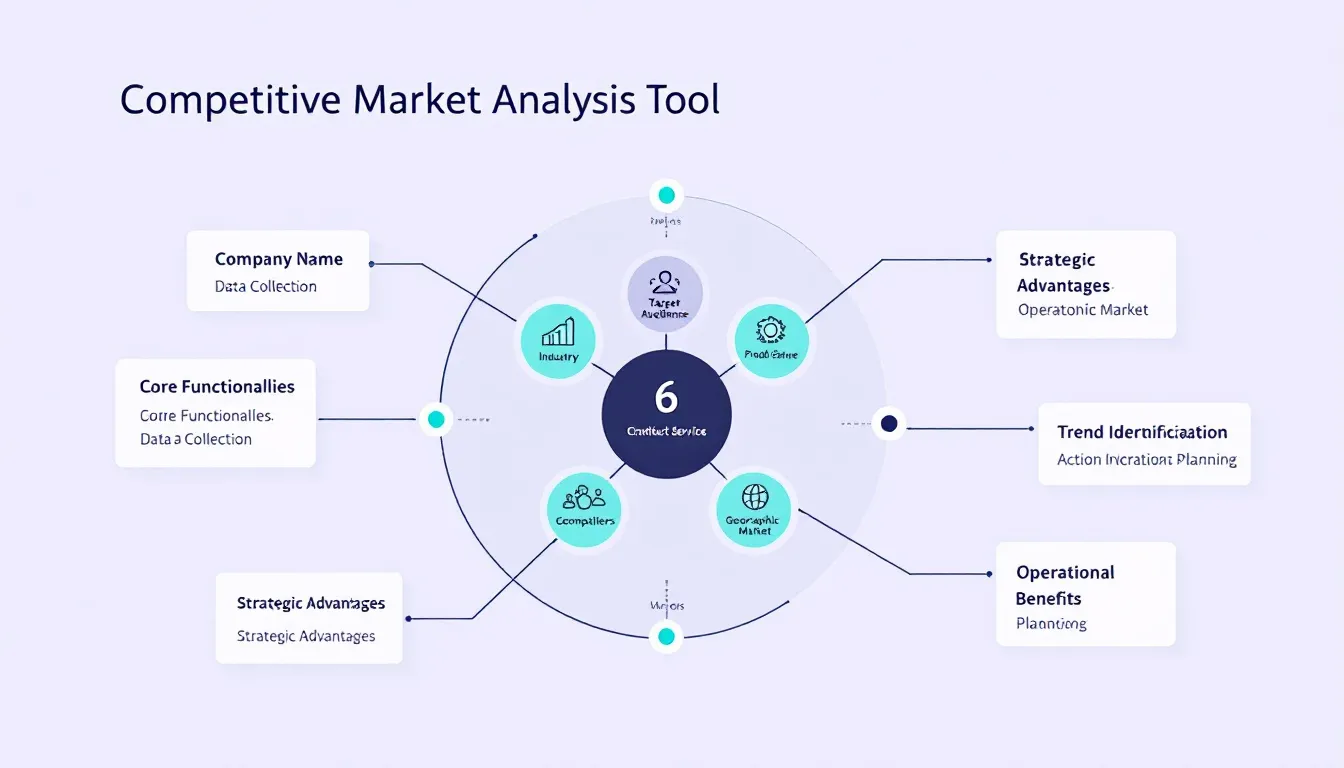Is this tool helpful?
How to Use the Competitive Market Analysis Tool Effectively
Follow these step-by-step instructions to get the most accurate and useful insights from the Competitive Market Analysis Tool. Each field helps refine your analysis and tailor recommendations for your business.
Step-by-Step Field Guide
- Company Name: Enter your official business name clearly. Example: “BrightWave Technologies” or “OceanSprout Organics”
- Industry or Market Sector: Identify your primary business category. Example: “Renewable Energy Solutions” or “Mobile App Development”
- Target Audience Description: Define your ideal customer profile including demographics, behaviors, and specific needs. Be clear about age range, income, and key challenges they face. Example: “Middle-aged professionals seeking eco-friendly products” or “Young adults interested in fitness technology.”
- Product/Service Description: Describe your main offerings, focusing on features and benefits. Highlight what sets your solutions apart. Example: “A subscription-based smart home automation system with AI integration” or “Custom eco-friendly apparel for outdoor enthusiasts.”
- Known Competitors: Enter names of direct market competitors, separated by commas. While optional, this input improves the precision of your competitive landscape. Example: “EcoSmart Devices, GreenPath Technologies”
- Geographic Market Focus: Specify your core sales or service regions. This helps the tool provide geographically relevant insights. Example: “Southeast Asia and Australia” or “Western Europe urban centers”
What Is the Competitive Market Analysis Tool?
The Competitive Market Analysis Tool helps you understand where your business stands compared to competitors. It examines your industry, target audience, product offerings, and market geography to generate actionable insights. These insights assist you in strengthening your market position and identifying growth opportunities.
Purpose and Benefits
- Identify your direct and indirect competitors accurately
- Assess your market positioning compared to others
- Align your product strategy with customer needs
- Recognize clear differentiation points to stand out
- Receive focused recommendations for marketing and strategic planning
How to Apply This Tool in Practice
This tool enables you to gather detailed competitive intelligence through straightforward inputs. Its analysis empowers you to develop well-informed market strategies.
Sample Use Case:
Example: A local organic skincare company uses the tool to map its competitors and market position. By entering product details and specifying its target customer base, the tool highlights opportunities for differentiation based on ingredient sourcing and sustainability.
- Market Position: Premium natural skincare provider
- Target Audience: Health-conscious women aged 25-45
- Key Differentiators: Locally sourced ingredients and eco-friendly packaging
- Geographic Focus: Northeastern United States
These insights help the company refine its messaging and target marketing campaigns more effectively.
Additional Practical Uses
- Track evolving competitors and market trends over time
- Compare pricing structures and features across competitors
- Identify gaps in customer needs to inspire new product development
- Create strategic marketing plans aligned to customer demographics
Key Features and Functionalities
- Competitor identification: Lists and evaluates your market rivals for clearer understanding
- Market positioning assessment: Determines your relative standing and suggests positioning tactics
- Target audience alignment: Analyzes whether your offerings meet customer needs effectively
- Differentiation opportunity detection: Highlights uniqueness to emphasize in your branding
- Strategic recommendations: Proposes focused steps to improve market share and visibility
Why Use This Competitive Analysis Tool?
Strategic Advantages
- Gain a comprehensive view of your competitive landscape
- Make data-driven decisions on business positioning
- Uncover clear opportunities for differentiation
- Develop more targeted and effective marketing strategies
- Reduce risks by anticipating competitor moves and market trends
Operational Benefits
- Perform structured, time-efficient market analysis
- Use systematic criteria to evaluate competitors
- Generate actionable insights for planning and growth
- Support product development and innovation initiatives
- Streamline strategic decision-making processes
Solving Core Market Positioning Challenges
The tool helps you tackle frequent business challenges through precise analysis:
- Evaluate market saturation and identify underserved segments
- Recognize your competitive advantages and weaknesses
- Confirm alignment between your products and target customers
- Assess growth opportunities in new geographic areas
- Build focused differentiation strategies that resonate with customers
Practical Industry Use Cases
Case Study 1: SaaS Business
A software-as-a-service startup mapped competitors using the tool to analyze feature sets and pricing tiers, enabling them to design unique pricing that attracts small and medium businesses more effectively.
Case Study 2: Health & Wellness Retail
An organic supplement company leveraged the tool to understand their competitors’ marketing approaches and tailor their messaging to health-conscious consumers seeking natural alternatives.
Frequently Asked Questions (FAQ)
General Questions
Q: How often should I update my competitive analysis?
A: Ideally, update quarterly or whenever major changes happen in your industry to stay ahead.
Q: Can this tool support global market analysis?
A: Yes, by specifying geographic market focus, you get relevant insights for international regions.
Q: How detailed should I be in product descriptions?
A: Include key features, benefits, and what makes your products stand out, but keep it concise and clear.
Q: What defines a solid competitor analysis?
A: Focus on direct competitors’ strengths and weaknesses, market positioning, and unique offers.
Strategic Application
Q: How do I use the analysis results effectively?
A: Apply them to refine marketing tactics, improve product features, and adjust positioning strategies.
Q: Should I include indirect competitors?
A: Yes, including indirect competitors helps you understand the broader market and potential threats.
Q: How specific should my target audience description be?
A: Include demographics, interests, behaviors, and pain points for accurate analysis.
Best Practices
Q: How do I differentiate my business with this tool?
A: Highlight unique value propositions that align closely with customer needs.
Q: How can I enhance the tool’s performance?
A: Provide thorough and accurate inputs, and revisit your analysis regularly as your market evolves.
Q: Should I focus on pricing or value differentiation?
A: Use the tool’s insights to choose the strategy that best fits your competitive standing and customer expectations.
Additional Insights for Continuous Improvement
Tracking Market Evolution
Regular analysis helps you keep track of emerging competitors, shifting trends, and evolving customer preferences, enabling you to discover new opportunities and avoid risks.
- Monitor new competitors entering your market
- Analyze trends shaping industry and customer needs
- Adjust strategies based on shifting geographic demands
- Recognize potential gaps to innovate and grow
Implementing Results Strategically
- Hold strategic planning sessions informed by analysis findings
- Develop marketing campaigns that reflect competitive advantages
- Drive product improvements to meet uncovered customer needs
- Enhance overall customer experience and brand differentiation
Important Disclaimer
The calculations, results, and content provided by our tools are not guaranteed to be accurate, complete, or reliable. Users are responsible for verifying and interpreting the results. Our content and tools may contain errors, biases, or inconsistencies. Do not enter personal data, sensitive information, or personally identifiable information in our web forms or tools. Such data entry violates our terms of service and may result in unauthorized disclosure to third parties. We reserve the right to save inputs and outputs from our tools for the purposes of error debugging, bias identification, and performance improvement. External companies providing AI models used in our tools may also save and process data in accordance with their own policies. By using our tools, you consent to this data collection and processing. We reserve the right to limit the usage of our tools based on current usability factors.







